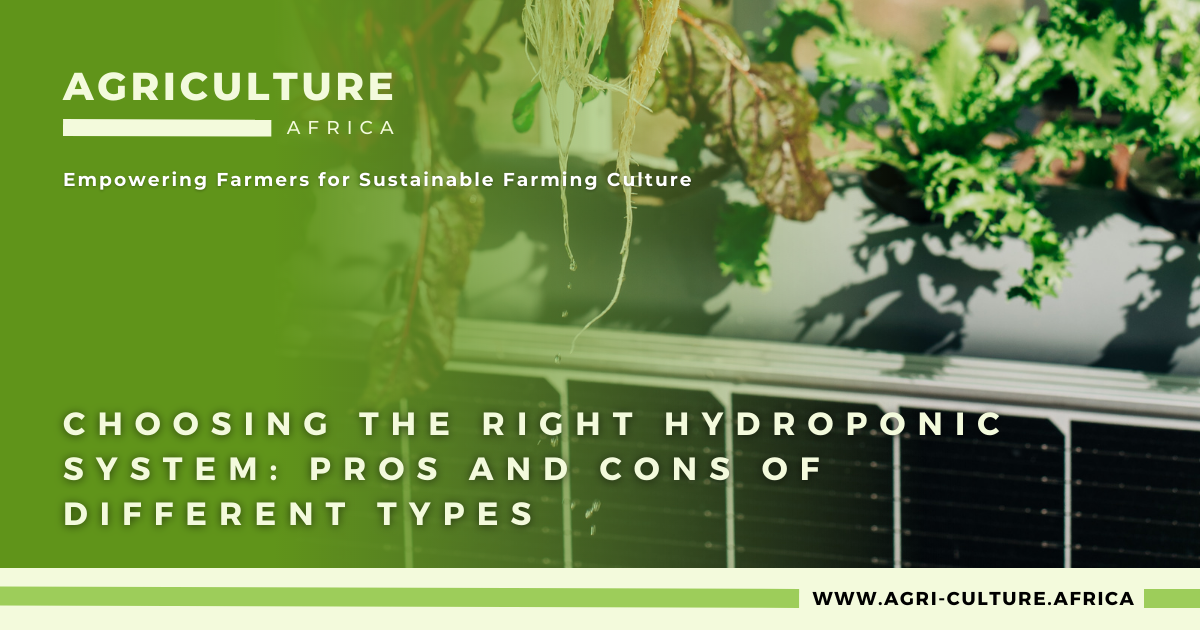
Empowering African Farmers for Sustainable Farming Culture
Hydroponic gardening is gaining popularity as a method of growing plants without soil. Farmers can now produce high yields of crops in small spaces while using less water and fertiliser than traditional farming methods. But, with so many different types of hydroponic systems to choose from, how do you know which one is right for you? In this article, we’ll go over the various types of hydroponic systems available, as well as the benefits and drawbacks of each.
A drip irrigation system is a hydroponic setup that uses drip emitters to deliver nutrient solution directly to plant roots. This system is simple to install and can be used to grow a variety of crops such as vegetables, fruits, and flowers. This system’s main advantage is that it allows for precise control of the amount of water and nutrients delivered to each plant. This saves water and prevents over-fertilization. The drip emitters, on the other hand, can become clogged with mineral deposits, reducing the system’s efficiency.
A deep water culture system is a hydroponic system in which plants are suspended in a nutrient-rich solution. The plants’ roots dangle in the solution, allowing them to absorb the nutrients they require to grow. This simple system is ideal for growing leafy greens and herbs. The main advantage of this system is that it provides the roots with a high level of oxygenation, which can promote healthy growth. However, maintaining proper nutrient levels in the solution can be difficult, and the system can become contaminated if the water is not properly sterilised.
A nutrient film technique system is a hydroponic system that bathes the plant roots in a thin layer of nutrient solution. A thin film of nutrient solution is continuously pumped through the trough as the roots are suspended in it. This system is ideal for growing crops that grow quickly, such as lettuce and herbs. The main benefit of this system is that it allows for precise control of the nutrient solution, which can aid in yield optimisation. The system, however, can be difficult to set up and maintain, and it is vulnerable to power outages or pump failures.
A hydroponic system that suspends plant roots in the air and sprays them with a fine mist of nutrient solution is known as an aeroponic system. This system is ideal for growing plants that need a lot of oxygen, like tomatoes and peppers. This system’s main advantage is that it provides excellent aeration to the roots, which can promote healthy growth. However, maintaining proper nutrient levels in the mist can be difficult, and the system is susceptible to power outages or pump failures.
An ebb and flow system is a hydroponic system that floods the roots of the plants with nutrient solution before draining it. The system is intended to mimic natural tidal cycles, which can encourage healthy growth. This system is ideal for growing a wide range of crops such as vegetables, fruits, and flowers. The main benefit of this system is that it is simple to set up and can be used for a wide range of crops. However, maintaining proper nutrient levels in the solution can be difficult, and the system can become contaminated if the water is not properly sterilised.
Choosing the right hydroponic system depends on a variety of factors, including the type of crop you want to grow, the amount of space you have available, and your budget. Each system has its pros and cons
Your donation fuels change! Help Agriculture Culture in Africa empower farmers with resources, training, and access to innovation. Together, we can revolutionize African agriculture.

Empowering Sustainable Growth and Innovation in African Agriculture
Sign up to our newsletter